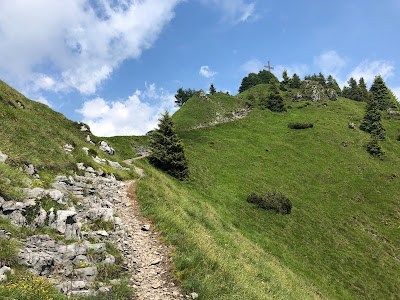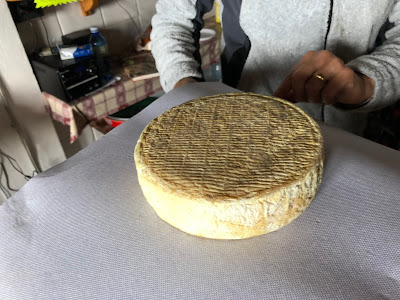



Upper Left: A Cow Grazing on Monte Farno with Roccolo del Moret in the background. Upper Right: GPS tracks of the hike to Rifugio Parafulmine. Lower Left: Astrantia major - Great Masterwort. Lower Right: A Green Dock Beetle on Knautia.
Overview
Length: 10.25 km (6.4 mi)
Duration: 4 hours total, with 45 minute lunch break at Rifugio Parafulmine
Elevation: 1200 m (3,937 ft) @ start/end of hike near Monte Farno; 1,636 m (5,367 ft) @ Pizzo Formico – highest point
Location: Italy, Lombardy, Bergamo Province, Val Seriana
Details
Our first hike of the season takes us 25 minutes by car
outside of Bergamo for a return visit to the area above Gandino called the conca del Farno. We were last here in July
2017, described in the post A
Hike from Clusone to Rifugio Parafulmine. For the 2017 hike, we used buses
to get back and forth to Bergamo. This time we caught a ride with a friend. The
way we did it today is in fact the more common way to hike this area. To arrive,
you drive up to Monte Farno area, park and then start walking. There are
several parking areas. This being a weekday with hardly anybody there, we were
able to park in the uppermost lot, just after the Chiesa della Madonna Addolorata al
Monte Farno and just before Ristorante Monte Farno.
In this hike we made a clockwise loop, following the crest
trail (sentiero 542)
and coming back on lower trail/road (sentiero 545). At
Rifugio Parafulmine (1536 m), there was no stinco
di maiale (pork shank) today, but we consoled ourselves with a homemade formaggella
(cheese). We had been thinking about that stinco
for one year and now we’ll just have to come back.
On today’s hike, we really noticed the Roccolo del Moret,
perhaps because we approached from below whereas last time (in 2017) we came
from above and didn’t notice it. It is quite hidden when you are above it.
Finally, two language notes. Formico is pronounced with
the stress on the -o. It’s a word with
the tonic stress on the third-from-last syllable which we’ve discussed ad nauseam
here.
In the Bergamasco dialect, Pizzo
Formico is Péz Fürmiga. And, the name of the rifugio parafulmine means lightening rod. You wouldn't want get caught in this exposed meadow in a storm.






Views of the trail from left to right: 1. Approaching Pizzo Formico. 2. Passing through some grazing cows. 3. Roccolo del Moret from below. 4. Start of the hike with meadow and flowers. 5. Roccolo del Moret on the hill. 6. Below Rifugio Parafulmine, view back toward Monte Farno.






Views of the trail from left to right: 1. Approaching Pizzo Formico. 2. Passing through some grazing cows. 3. Roccolo del Moret from below. 4. Start of the hike with meadow and flowers. 5. Roccolo del Moret on the hill. 6. Below Rifugio Parafulmine, view back toward Monte Farno.
Flora
When we were here in July 2017, the meadows making up the conca del Farno were starting to turn
brown. Today, a month or so earlier in the season, we found the meadows very
green and filled with flowers. Here’s a list of some of the plants we saw that also have a photo included in this post.
For help identifying plant on hikes around Bergamo, see the
post Resources
for Identifying Plants around Bergamo.
Key: [Family] Genus
species – Common name in English (Common name in Italian)
[Apiaceae] Astrantia
major – Great Masterwort (Astranzia
maggiore)
[Apiacaea] Mutellina
adonidifolia – Alpine Lovage (Motellina
con foglie di adonide)
[Asteraceae] Cirsium
erisithales – Yellow Thistle (Cardo
zampa d'orso)
[Campanulaceae] Phyteuma
scheuchzeri – Oxford Rampion (Raponzolo
di Scheuchzer).
- This could be one of several genus of Phyteuma, but I’m going with scheuchzeri because it most closely matched bloom time and elevation criteria.
[Caryophyllaceae] Silene
vulgaris – Bladder Campion (Silene rigonfia)
[Fabaceae] Anthyllis
vulneraria – Lady’s Fingers (Vulneraria)
[Fabaceae] Laburnum anagyroides
– Common Laburnum (Maggiociondolo)
- According to Fiori delle Orobie (references), common Laburnum rarely goes about 1200 m. We saw this just slightly above 1200 m. We’ll go with common Laburnum rather than L. alpinum or alpine Laburnum. A close inspection of young branches and leaves could have resolved it, but I didn’t look.
[Fabaceae] Trifolium
montanum – Mountain Clover (Trifoglio
montano)
[Lamiaceae] Clinopodium
alpinum – Alpine Calamint (Acino
alpino, Santoreggia alpina)
[Lamiaceae] Prunella
vulgaris – Common Self-Heal (Prunella
commune)
[Lamiaceae] Stachys
alopecuros – White Betony (Betonica
bianca)
[Lamiaceae] Thymus serpyllum
– Wild Thyme (serpillo)
[Orchidaceae] Cephalanthera
longifolia – Narrow-leaved Helleborine (Cefalantera
maggiore)
[Orchidaceae] Dactylorhiza
maculata – Heath-Spotted Orchid (Orchide macchiata)
[Orchidaceae] Gymnadenia
conopsea – Fragrant Orchid (Manina
rosa)
[Orobanchaceae] Pedicularis
spp. – Lousewort (Pediculare)
[Orobanchaceae] Rhinanthus
alectorolphus - Greater Yellow Rattle (Cresta
di gallo comune)
[Plantaginaceae] Globularia
cordifolia – Matted Globularia (Vedovella
a foglie cordate)
[Polygonaceae] Persicaria
bistorta – Common Bistort (Poligono
bistorta)
[Polygalaceae] Polygala
spp. – Milkwort (Poligala)
[Ranunculaceae] Trollius
eruopaeus – Globeflower (Botton d’oro)
[Rosaceae] Rosa pendulina
– Alpine Rose (Rosa alpina)
[Saxifragaceae] Saxifraga spp.,
possibly S. mutata
[Scrophulariaceae] Verbascum – Mullein (Verbasco)![[Caryophyllaceae] Silene vulgaris – Bladder Campion (Silene rigonfia). [Caryophyllaceae] Silene vulgaris – Bladder Campion (Silene rigonfia).](https://blogger.googleusercontent.com/img/b/R29vZ2xl/AVvXsEgBIU6qGvI-kz5DIGOf2Gsh9Q1Ts52jDbWsl7Ou92NRlg9Z6-7J87HIehrEm1atup-ZX5IpC8izfxKo2V64aoDO8hOXuMcdY6J3oqRYVQ9KpN8xzAHc_tFiSa2M1E7-6BUHwXqt_exM1w/s400/Flora+-+%255BCaryophyllaceae+-+Silene+vulgaris.jpg)
![[Fabaceae] Trifolium montanum – Mountain Clover (Trifoglio montano). [Fabaceae] Trifolium montanum – Mountain Clover (Trifoglio montano).](https://blogger.googleusercontent.com/img/b/R29vZ2xl/AVvXsEg-DcEg7JalY4tVGJfQwFPsIX1IRXMRokh3T68LPep86vzLDk_me-fuaBhiGaRD9Vf799_EkQE_bK_67XalFh9BkNgbmCVLUFzkoYdpyysQ0cKB1tBjOjK8sZAoiIqpO2Rb1y2e4o6upQ/s400/Flora+-+%255BFabaceae%255D+Trifolium+montanum.jpg)
![[Rosaceae] Rosa pendulina – Alpine Rose (Rosa alpina). [Rosaceae] Rosa pendulina – Alpine Rose (Rosa alpina).](https://blogger.googleusercontent.com/img/b/R29vZ2xl/AVvXsEiJqqHIMWPGRvmP4sU5lcO3mlnsEpZJPp_g5WukkwY2X61osC0b3z2vNDetQWEEb738H_8tWGlr5ORtN5WGGA_f6k60M_dl7XgQSRIxu9fODpLVaYd4-ITiq5u2Ky0G5L7T7DbD_FRI9g/s400/Flora+-+%255BRosaceae%255D+Rosa+pendulina.jpg)
Left: [Caryophyllaceae] Silene vulgaris – Bladder Campion (Silene rigonfia). Center: [Fabaceae] Trifolium montanum – Mountain Clover (Trifoglio montano). Right: [Rosaceae] Rosa pendulina – Alpine Rose (Rosa alpina).
![[Fabaceae] Laburnum anagyroides – Common Laburnum (Maggiociondolo) [Fabaceae] Laburnum anagyroides – Common Laburnum (Maggiociondolo)](https://blogger.googleusercontent.com/img/b/R29vZ2xl/AVvXsEg0T1hvaf57GxdCv9plcewF-qi6trseIsv1FitCaOrAf61hrmiCNgiRnZEFH-VBhpuiJN3lv-2SZ4fXvSDy9ajBTWc-cFMA1d75X47R93XOjJdxcdgsSqQHSeTbUer6q9wyP0kD3L2-rg/s400/Flora+-+%255BFabaceae%255D+Laburnum+anagyroides+raceme.jpg)
![[Fabaceae] Laburnum anagyroides – Common Laburnum (Maggiociondolo) [Fabaceae] Laburnum anagyroides – Common Laburnum (Maggiociondolo)](https://blogger.googleusercontent.com/img/b/R29vZ2xl/AVvXsEgmkvoVlvlOVFzMaDjR2EYSM7BLwJOTZzxx17Rn-hHSvPzn8CQkEXojyjAY9UY0W9FAE_l5XF3AKSOAAqlONcDrGjdV1oBrVodYxF4Nc6UC7DWSY9b0hT-mUd5qFs1P7b4a7FjnEc0FUg/s400/Flora+-+%255BFabaceae%255D+Laburnum+anagyroides.jpg)
![[Ranunculaceae] Trollius eruopaeus – Globeflower (Botton d’oro) [Ranunculaceae] Trollius eruopaeus – Globeflower (Botton d’oro)](https://blogger.googleusercontent.com/img/b/R29vZ2xl/AVvXsEjT6p7iZnWiURct4z4_eXZxzHKUaeS_8dKUkC3lTUFYMubMeThSwYjupo0r9rnUURyFL0zQ7FLswum9BeE6MlGTVIIqwYjABzPUAM0g4jLcRLN1H52OLd2L_7-OYXW__qw82QFUsD-PEg/s400/Flora+-+%255BRanunculaceae%255D+Trollius+eruopaeus.jpg)
Left and Center: [Fabaceae] Laburnum anagyroides – Common Laburnum (Maggiociondolo)
Right: [Ranunculaceae] Trollius eruopaeus – Globeflower (Botton d’oro)
![[Lamiaceae] Clinopodium alpinum – Alpine Calamint (Acino alpino, Santoreggia alpina) [Lamiaceae] Clinopodium alpinum – Alpine Calamint (Acino alpino, Santoreggia alpina)](https://blogger.googleusercontent.com/img/b/R29vZ2xl/AVvXsEiTd1LJmX1fZETBs_GNIiWMcflvUZjmGgCdhjvL7a95gpFPa4bSHKznKHb5G5uTRAl6SFBgguriMQ0BkBC1Y1r8FrUGIaHM3m1_ffPAlRMxdzrj5SxqT3-Zvn8q5Kym9RzXPOuqQKKL8w/s400/Flora+-+%255BLamiaceae%255D+Clinopodium+alpina.jpg)
![[Plantaginaceae] Globularia cordifolia – Matted Globularia (Vedovella a foglie cordate) [Plantaginaceae] Globularia cordifolia – Matted Globularia (Vedovella a foglie cordate)](https://blogger.googleusercontent.com/img/b/R29vZ2xl/AVvXsEj9p98UuOOMyFELp6MXjFP2dX6kiKmvoXS94EdGR0f9vdNSy7hmhb3tRjtM6r6wR7zIXe3QSE-kC2ZijAstrYpyhxzs7zRezCRCZjrIYMIbe2PYoTH0ZtlRk6DPr_wZE5r258FOqwKZoA/s400/Flora+-+%255BPlantaginaceae%255D+Globularia+cordifolia.jpg)

Left: [Lamiaceae] Clinopodium alpinum – Alpine Calamint (Acino alpino, Santoreggia alpina)
Center: [Plantaginaceae] Globularia cordifolia – Matted Globularia (Vedovella a foglie cordate)
Right: Lousewort and Lady's Mantle
![[Lamiaceae] Prunella vulgaris – Common Self-Heal (Prunella commune) [Lamiaceae] Prunella vulgaris – Common Self-Heal (Prunella commune)](https://blogger.googleusercontent.com/img/b/R29vZ2xl/AVvXsEg_zOpxiLOcR2swvaTml_iQPiuhesuMuUy3Ddyf-rMN7__AcyOHyPeFRUDOTvJlP0OYcCROTYbp-xhUjt056NA7I8fMhHl-Ro8Yh4lvumabeKDrUQyPBkrETRwcPNs7MRwwsafJ0V2zTQ/s400/Flora+-+%255BLamiaceae%255D+Prunella+vulgaris.jpg)
![[Lamiaceae] Thymus serpyllum – Wild Thyme (serpillo) [Lamiaceae] Thymus serpyllum – Wild Thyme (serpillo)](https://blogger.googleusercontent.com/img/b/R29vZ2xl/AVvXsEiZsYJB-lZvUJ0uqmA7hv9QjPoW1jvZDUSVwsZw4CzzCY3YJKfWli6CgW-O5DKWuTXkVitUU3CIvvcHUoGJlsIjfLpJW_bJSu4bBHkn1HZNylnheTIVlSUuasEUZsbfoHfXdUpvx1fjaA/s400/Flora+-+%255BLamiaceae%255D+Thymus+praecox.jpg)
![[Campanulaceae] Phyteuma scheuchzeri [Campanulaceae] Phyteuma scheuchzeri](https://blogger.googleusercontent.com/img/b/R29vZ2xl/AVvXsEibwVB8N9FSSbPMmTvxzBrhyphenhyphencHHKg2q3iv6-FuTbUr-Z5T95sKlfzeMvomOTz11VU9tBukYFERyhBkl6Mok6SLDKRZGOdlZoPnoZ0LOz1jR9rLIhkTq6UZ0ugcmF4JIxf7Mq_vfCLEvSQ/s400/Flora+-+%255BCampanulaceae%255D+Phyteuma.jpg)
Left: [Lamiaceae] Prunella vulgaris – Common Self-Heal (Prunella commune)
Center: [Lamiaceae] Thymus serpyllum – Wild Thyme (serpillo)
Right: [Campanulaceae] Phyteuma scheuchzeri
![[Orchidaceae] Cephalanthera longifolia – Narrow-leaved Helleborine (Cefalantera maggiore) [Orchidaceae] Cephalanthera longifolia – Narrow-leaved Helleborine (Cefalantera maggiore)](https://blogger.googleusercontent.com/img/b/R29vZ2xl/AVvXsEgjwRn_V9KteFy7KuWz1tkyLVSqh9ZaN-5biUuaG_gAByyeaBD973Xf_zjux5F7Cx4MIQLvV4IndpFpa7TV4Bz-FoPUEMSbtzVfdQnTVwLbPXexx-vLpLNNi_U1n29fGDyTgzdK24qWpQ/s400/Flora+-+%255BOrchidaceae%255D+Cephalanthera+longifolia.jpg)
![[Orchidaceae] Dactylorhiza maculata – Heath-Spotted Orchid (Orchide macchiata) [Orchidaceae] Dactylorhiza maculata – Heath-Spotted Orchid (Orchide macchiata)](https://blogger.googleusercontent.com/img/b/R29vZ2xl/AVvXsEgXBD7s6hnEzPxgn9vfi6xSSEZ1JZ8Qm3OXGv9tKj2tTxZ6A0LNtiGuDM-rlvphua-s_WmSQLRECDvkveY24dnjjzg16TLZJBH3dFqvN75bOWL6NTNz1fEeinFqrO7WFetWmPmlUBV2FQ/s400/Flora+-+%255BOrchidaceae%255D+Dactylorhiza+maculata.jpg)
![[Polygonaceae] Persicaria bistorta – Common Bistort (Poligono bistorta) [Polygonaceae] Persicaria bistorta – Common Bistort (Poligono bistorta)](https://blogger.googleusercontent.com/img/b/R29vZ2xl/AVvXsEhy0nbjOvJViZUKWwQzme6G8AADlzE73CcQnzHAXXq2v3seE7l1TOFVnF7mA6ZqtzmKwnwLYO9rCJLirke6DClG_X9RyXmNuvS-oSDSzJg0BTQ4ujxIflgARJMrVMKZz6H4SF027bDT0g/s400/Flora+-+%255BPolygonaceae%255D+Persicaria+bistorta.jpg)
Left: [Orchidaceae] Cephalanthera longifolia – Narrow-leaved Helleborine (Cefalantera maggiore)
Center: [Orchidaceae] Dactylorhiza maculata – Heath-Spotted Orchid (Orchide macchiata)
![[Orchidaceae] Gymnadenia conopsea – Fragrant Orchid (Manina rosa) [Orchidaceae] Gymnadenia conopsea – Fragrant Orchid (Manina rosa)](https://blogger.googleusercontent.com/img/b/R29vZ2xl/AVvXsEiAXXiI4E66skUeD-zmspV5lfjXfwGb1iXiyfvBROqSgPTy8vYJc8w1iRJ7phjqkkZJhSFXvDoLkQAzBnJdRBqBfP2Ysx5w3SqO5YapFxn0-SGa6kTlIHv3S7fGD6IKzAY3Y1NGSK1b1Q/s400/Flora+-+%255BOrchidaceae%255D+Gymnadenia+conopsea.jpg)
![[Fabaceae] Anthyllis vulneraria – Lady’s Fingers (Vulneraria) [Fabaceae] Anthyllis vulneraria – Lady’s Fingers (Vulneraria)](https://blogger.googleusercontent.com/img/b/R29vZ2xl/AVvXsEgU_FWslmglUn-Ig535BFNTMA3vehmMrKnLSyR88rf26Biwzxm1rbCiLQo-m3gF0fv1TpoJroOT8ugVYwHE-L5WogSlogkhWvGYuShhgpJWNqJzn_SA9Cl-okU5aA5f-RsDAnvH0ZUaQw/s400/Flora+%255BFabaceae%255D+Anthyllis+vulneraria.jpg)
Left: [Orchidaceae] Gymnadenia conopsea – Fragrant Orchid (Manina rosa)
Right: [Fabaceae] Anthyllis vulneraria – Lady’s Fingers (Vulneraria)
![[Orobanchaceae] Pedicularis spp. – Lousewort (Pediculare) [Orobanchaceae] Pedicularis spp. – Lousewort (Pediculare)](https://blogger.googleusercontent.com/img/b/R29vZ2xl/AVvXsEhBJhabjgXslsYy35tKn6WuURjrY5Ad7sm_UnmWJWFvPV9Rl89y-NweqjFBoSoRQAYQq-QFkNuDQPc0Wu7WujKg-5x12W4wLNGbFqxzo7YbwfiXqupjks4dkrqdrhrGGLln1GHViuCeLA/s400/Flora+-+%255BOrobanchaceae%255D+Pedicularis+1.jpg)
![[Orobanchaceae] Pedicularis spp. – Lousewort (Pediculare) [Orobanchaceae] Pedicularis spp. – Lousewort (Pediculare)](https://blogger.googleusercontent.com/img/b/R29vZ2xl/AVvXsEgWh2mwRnuC_C0UfJTI3AVMVC0iOSM_A8QxXTk1jo2aQCYtQdgiay_vIlnkOlJqmu1ZXuylAmrdwZj6sGhPjCsb5tcBrppRrjRvqnX202mMUBt7iIrug32NkxeC5jnfHxHrv0HGaXz0zw/s400/Flora+-+%255BOrobanchaceae%255D+Pedicularis+2.jpg)
![[Orobanchaceae] Pedicularis spp. – Lousewort (Pediculare) [Orobanchaceae] Pedicularis spp. – Lousewort (Pediculare)](https://blogger.googleusercontent.com/img/b/R29vZ2xl/AVvXsEgMsL6SI1nA7UbwuwStVZuPzeONWXBbr-6uLdlqZuFtbZYGUgzqqFP12xIN-8ix1DRLdtocakwNkgp-kpnvm3hrpG_XVpu_rEE4x3d9vZUlQv1S59waNvqiRJd80tL69dN91lPzuQXPDw/s400/Flora+-+%255BOrobanchaceae%255D+Pedicularis+3.jpg)
Various [Orobanchaceae] Pedicularis spp. – Lousewort (Pediculare). Purple, white, and yellow.
![[Scrophulariaceae] Verbascum – Mullein (Verbasco) [Scrophulariaceae] Verbascum – Mullein (Verbasco)](https://blogger.googleusercontent.com/img/b/R29vZ2xl/AVvXsEiapbOSR3EsWa0wX8Sda-L-uNkd4Gvt2-aqM1IqOyPME3tK8VGWdBK_cbTE4_tc6-AjnzPq_zBDNxGKnBqAhQSKodTcYGK55RmovCTl4NEM6vqFk-0Cm9C_AVkPGqnP7YStTExh6hfD2A/s400/Flora+-+%255BScrophulariaceae%255D+Verbascum.jpg)
![[Asteraceae] Cirsium erisithales – Yellow Thistle (Cardo zampa d'orso) [Asteraceae] Cirsium erisithales – Yellow Thistle (Cardo zampa d'orso)](https://blogger.googleusercontent.com/img/b/R29vZ2xl/AVvXsEgLruSdouOV-Op3K4aODhxA4H2GknS95Qk67HykQl7RZq88pFZTINxb0N_l7hzsBDaof3vymhF1YGb0qkmtr4JFbwHxly7v04gXYDLmiAIgcfuBx88s3ClM63VHSHXtoZlAXd18-sKEyQ/s400/Flora+-+%255BAsteraceae%255D+Cirsium+erisithales+.jpg)
![[Orobanchaceae] Rhinanthus alectorolphus - Greater Yellow Rattle (Cresta di gallo comune) [Orobanchaceae] Rhinanthus alectorolphus - Greater Yellow Rattle (Cresta di gallo comune)](https://blogger.googleusercontent.com/img/b/R29vZ2xl/AVvXsEiCh33xkDoR8kiOhknxbDbDomRGHRo07QKkPDLKN5AJChaxoggySy4E5IcYyX3X45b2VVeOPXWpTu3CKI-gBzFDPwZtAxVkrIfTKnKgTcZrrViv3sk3-TGS2FJZEtMHyC20DG9nr_nglA/s400/Flora+-+%255BOrobanchaceae%255D+Rhinanthus+alectorolphus.jpg)
Left: [Scrophulariaceae] Verbascum – Mullein (Verbasco)
Center: [Asteraceae] Cirsium erisithales – Yellow Thistle (Cardo zampa d'orso)
Right: [Orobanchaceae] Rhinanthus alectorolphus - Greater Yellow Rattle (Cresta di gallo comune)
![[Polygalaceae] Polygala spp. – Milkwort (Poligala) [Polygalaceae] Polygala spp. – Milkwort (Poligala)](https://blogger.googleusercontent.com/img/b/R29vZ2xl/AVvXsEjo-DI4kD8VowIspRlgVSpawQbrXEhODXhejoEKewU1CH6fdK4PNC560v-g_Fy4HRKmcInFabf-ebxkaQXi-Gmu5IPfm0oM8oLSg71cQuxT7eKI2L9u_yaOWt_wRToW_vA6zS4CRiG-7A/s400/Flora+-+%255BPolygalaceae%255D+Polygala.jpg)
![[Apiacaea] Mutellina adonidifolia – Alpine Lovage (Motellina con foglie di adonide) [Apiacaea] Mutellina adonidifolia – Alpine Lovage (Motellina con foglie di adonide)](https://blogger.googleusercontent.com/img/b/R29vZ2xl/AVvXsEiyjCwiEHUEDIoJjgn_iGOmgE6cjWubhxWMMaH9_uhttnKi4xJhjp3fqsbk4F7BHv4cASw9tx6-rfqH4jC0XZadcbs0AZ5pAnid88EnTQdcvqddX6yv28jzEZxPlH09BgLOU6gwVEwkTQ/s400/Flora+-+%255BApiacaea%255D+Mutellina+adonidifolia.jpg)
Left: [Polygalaceae] Polygala spp. – Milkwort (Poligala)
Right: [Apiacaea] Mutellina adonidifolia – Alpine Lovage (Motellina con foglie di adonide)
![[Saxifragaceae] Saxifraga spp., possibly S. mutata [Saxifragaceae] Saxifraga spp., possibly S. mutata](https://blogger.googleusercontent.com/img/b/R29vZ2xl/AVvXsEjoYwtAzV8C2UMQPlMd6SO76d3yfP_lIJ2BAZaqtIR-eKaqwDlKm39WsHR9Uu_cdV_ytUxxIip_gTZSPT84cBrZ8qlCoB4YScZ4US_xPNhIN4uJqwe9LXCXuksZ7zYkXq1uOPHCgpcOmQ/s400/Flora+-+%255BSaxifragaceae%255D+Sassifraga.jpg)

Left: [Saxifragaceae] Saxifraga spp., possibly S. mutata
Right: Formagella at Rifugio Parafulmine
No comments:
Post a Comment
All comments are moderated. If your comment doesn't appear right away, it was likely accepted. Check back in a day if you asked a question.